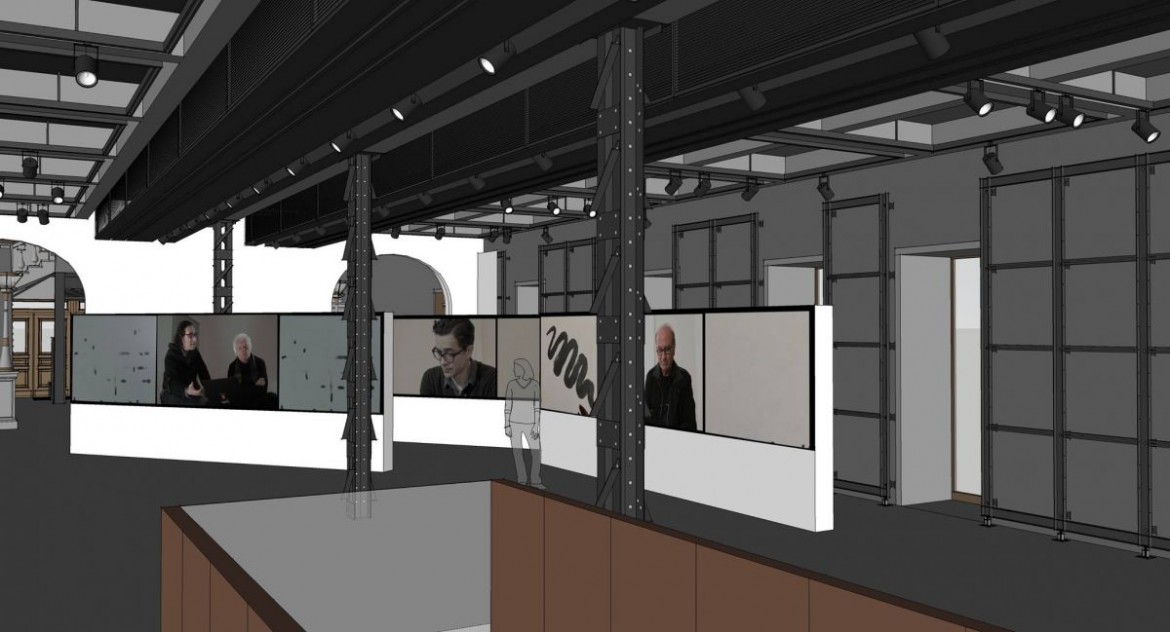
Boris Yukhananov and composer Dmitri Kourliandski met with students of the Institute of Liberal Arts and Sciences of the Moscow International University, where they talked about the principles on which work at the Stanislavsky Electrotheatre is based — new processualism and the open-circuited work space. They also presented Fading Apocalypse, an installation devoted to reflections on the role of the director, and how art is possible in the modern world.
Fading Apocalypse is a three-channel installation created by Boris Yukhananov in collaboration with artist Yelena Koptyaeva as a reflection of the personalities of three artists. Directors Heiner Goebbels, Theodoros Terzopoulos and Romeo Castellucci engage Yukhananov in dialogue, simultaneously applying water to a small stone plaque with a brush. The unpredictability of evaporating water triggers an associative series of thoughts related to the process of these artists' work on their productions. Creativity is every bit as unpredictable. The gradually evaporating drawings nevertheless reflect the methodology of each of the participating directors. The drawing process documented on video is projected on three screens; as you approach each monitor you hear the dialogue of the directors.
Authors: Boris Yukhananov, Yelena Koptyaeva
Sound design: Dmitri Kourliandski
Original languages: Russian, Italian, German, Greek.
Subtitles: Russian, English.
Critic Vadim Rutkovsky on the project:
“Fading Apocalypse is a three-channel video installation at the Stanislavsky Electrotheatre, a joint work of director Boris Yukhananov, artist Yelena Koptyaeva and composer Dmitri Kourliandski. On the surface it’s quite simple: recordings of leisurely conversations between Yukhananov and three prominent European directors, Heiner Goebbels, Theodore Terzopoulos and Romeo Castellucci, recorded during their collaborations at the Electrotheatre, are projected on monitors. In fact, this is all quite sophisticated. Dmitri Kourliandski accompanied the video with a sound loop, transforming it into a constantly resounding chord from one of Brahms' requiems. This sound dominates when you are at equal distances from the screens, but upon approaching one of them, you begin clearly to hear a specific dialogue that dissolves in the air as you move on further in space. Each conversation has a common theme, the creation of a performance, but each has its own motifs (Goebbels tends to abstraction; Castellucci, on the contrary, is generous with carnal memories). In addition to talking, each director picks up a brush and “draws” images with water on a stone surface. As the conversation continues, the drawing, which was so clear at the beginning, gradually disappears. However, the video is looped back - and the process repeats ad infinitum. This “dialogue with a stone” was originally intended for video documentation; the camera is as much an obligatory participant of Fading Apocalypse as water and words. Kourliandski called the Brahms requiem that he quotes the brightest of them all. As a definition, “light” is ideally suited to Fading Apocalypse (not only because of the white color of screens and the bright light in the lobby): The most obvious (and calming) message of this experience with the momentary and the eternal is that life and death are one and the same".
The exhibition runs until April 30, 2019.
Leningradsky prospect, 17.





